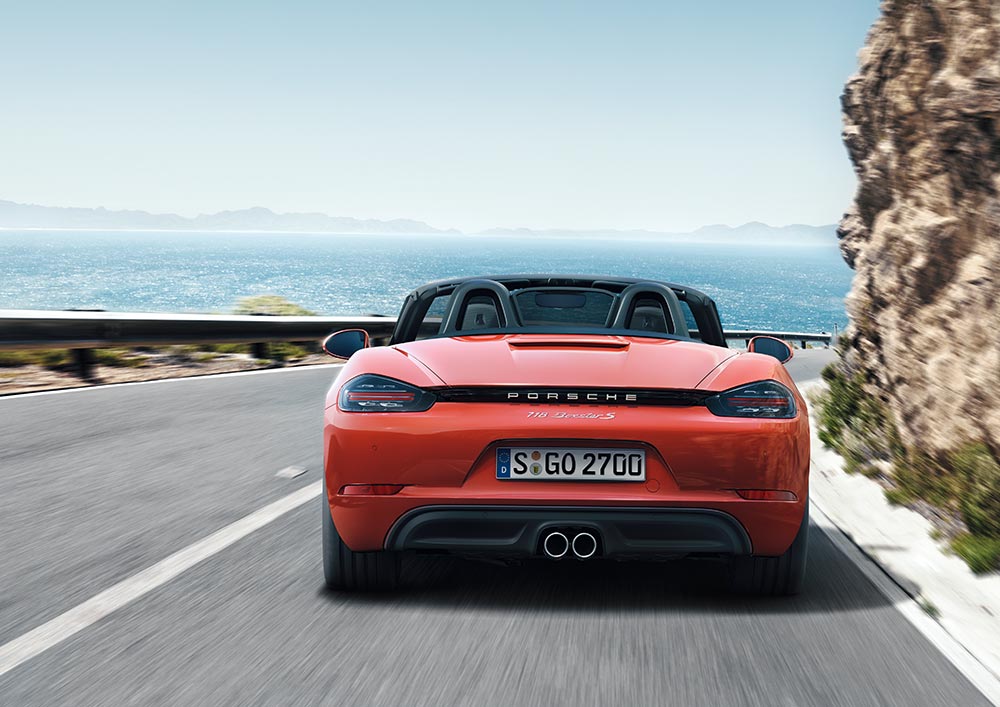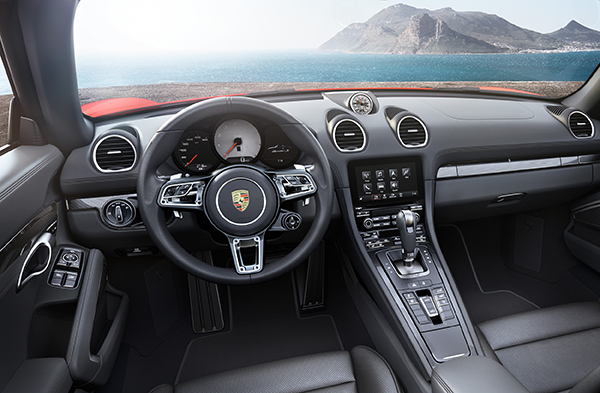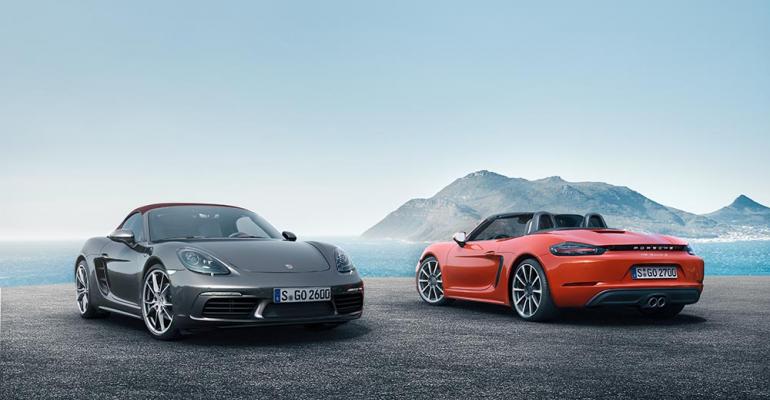STUTTGART – The initial range-topping version of Porsche’s all-new turbocharged horizontally opposed 4-cyl. gasoline engine will boast displacement of 2.5L and deliver 345 hp in the 718 Boxster S, the name the German automaker is resurrecting for its ’16 Boxster roadster line.
The model designation “718” harks back to Porsche racers of the late ’50s and early ’60s that were powered by flat 4-cylinder engines.
Set to make its public debut at the Geneva motor show in early March, the heavily reworked 2-seater is joined by the entry-level 718 Boxster running a smaller 2.0L turbo variant of the new 4-cyl. engine developing 296 hp, Porsche says.
The new models go on sale in North America in April, with an even more powerful 718 Boxster GTS set to join the range during the latter half of 2017.
Distinguishing the 718 Boxster and 718 Boxster S from the earlier Boxster and Boxster S are a series of mid-life styling changes, many of which are necessitated by a need to provide the new turbocharged engine with greater cooling capacity than its old naturally aspirated powerplant.
Styling follows the lineage established on the recently facelifted 911 with a new front bumper sporting larger cooling ducts and LED repeater lights on the leading edges and altered headlamps with optional LED daytime running lights. The flanks feature a new door handle design, revised sills and larger side air ducts.
The most significant styling change is reserved for the rear, where Porsche design boss Michael Mauer provides the 718 with a distinctive new appearance. First previewed on the Mission E concept at last year’s Frankfurt motor show, it sees an accent strip added between more structured taillamps featuring LED graphics to give the 718 additional visual width.
As with the models they replace, the 718 Boxster receives standard 18-in. wheels, while the 718 Boxster S rolls on 19-in. rims, although both are available with optional 20-in. wheels.
First 4-cyl. Porsches Since 1995
Arriving 3-1/2 years after the third-generation Boxster and Boxster S were introduced to the U.S. market, the 718 Boxster is the first Porsche model to offer a 4-cyl. engine since the 968 ceased production in 1995.
The new engine was developed under the guidance of Wolfgang Hatz, the head of Porsche’s R&D operations who was suspended in the aftermath of parent company Volkswagen’s Dieselgate affair in September 2015.
Produced at Porsche’s Zuffenhausen manufacturing plant near Stuttgart, Germany, it shares its internal architecture with and is built alongside the turbocharged 3.0L flat 6-cyl. engine recently unveiled in the facelifted 911.
The new 4-cyl. also replaces the existing naturally aspirated, horizontally opposed 6-cyl. in the 718 Cayman, which also is expected to premiere at Geneva.

In the 718 Boxster, the mid-mounted engine displaces 2.0L, making it the smallest unit to see service in a production-based Porsche sports car since the introduction of the 924 in 1976.
With 296 hp and 280 lb.-ft. (380 Nm) of torque between 1,950 and 4,500 rpm, it delivers 35 hp and 66 lb.-ft. (89 Nm) more than the naturally aspirated 2.7L flat-6 it replaces.
Significantly, the peak torque of the new forced-induction 4-cyl. arrives 1,500 rpm earlier than in the old 6-cyl., leading to what Porsche describes as added levels of low-end urge and greater mid-range flexibility.
The facelifted 718 Boxster S receives a larger 2.5L variant of the turbocharged 4-cyl. in place of the naturally aspirated 3.4L 6-cyl. used today. With 345 hp and 310 lb.-ft. (420 Nm) between 1,900 and 4,500 rpm, it offers a 34-hp increase in output along with 37 lb.-ft. (50 Nm) more torque.
As before, the most affordable Porsche sports cars offer the choice of a standard 6-speed manual or optional 7-speed dual-clutch PDK gearbox – the latter updated with a new software package that is claimed to provide added fuel efficiency.
Quicker And More Fuel-Efficient
Porsche says the 718 Boxster boasts a 0-62 mph (100 km/h) time of 4.7 seconds and 171-mph (275-km/h) top speed when fitted with the PDK, bettering its predecessor by 0.9 seconds and 5 mph (8 km/h).
The PDK-fitted 718 Boxster S boasts figures of 4.2 seconds and 177 mph (285 km/h), beating the official 0-62 mph time of the 378-hp 3.8L flat 6-cyl.-powered Boxster GT4 by 0.2 seconds.
As well as providing added power, the new 4-cyl. also brings a significant improvement in fuel economy over the old 6-cyl., with the 718 Boxster hitting a combined city/highway figure of 34 mpg (6.9 L/100 km) on the European test cycle and the 718 Boxster S posting 32 mpg (7.3 L/100 km) in combination with the PDK gearbox for respective increases of 4.2 mpg (1.8 km/L) and 3.5 mpg (1.5 km/L).
The adoption of the new engine has brought what Porsche describes as “sportier tuning of the chassis.” Included among the changes is a reworked electro-mechanical steering system that is said to be 10% more direct than the system used on the outgoing Boxster and Boxster S. Porsche’s Active Suspension Management continues as an option, offering a nominal 0.4 in. (10 mm) reduction in ride height over the standard suspension.

Inside, Porsche has updated the interior of the Boxster with a new 3-dial instrument panel and a 918 Spyder-inspired steering wheel complete with an optional rotary Sport Response dial allowing the driver to call up overboost for up to 20 seconds. There are four driving modes – Normal, Sport, Sport Plus and Individual – and the latest iteration of its Communication Management system featuring a new touchscreen and improved connectivity functions.





